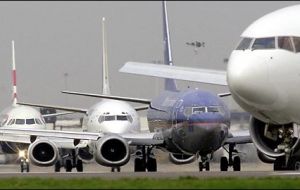MercoPress. South Atlantic News Agency
Air transport industry under intensive care during 2009

The International Air Transport Association (IATA) announced a revised outlook for the global air transport industry with losses of 4.7 billion USD dollars in 2009. This is significantly worse than IATA’s December forecast for a 2.5 billion loss in 2009, reflecting the rapid deterioration of the global economic conditions.
Industry revenues are expected to fall by 12% to 467 billion US dollars. By comparison, the previous revenue decline, after the events of 11 September 2001, saw industry revenues fall by 23 billion over the period of 2000 to 2002, approximately 7%.
“The state of the airline industry today is grim. Demand has deteriorated much more rapidly with the economic slowdown than could have been anticipated even a few months ago. Our loss forecast for 2009 is now 4.7 billion. Combined with an industry debt of 170 billion USD, the pressure on the industry balance sheet is extreme,” said Giovanni Bisignani, IATA Director General and CEO.
Demand is projected to fall sharply with passenger traffic expected to contract by 5.7% over the year. Revenue implications of this fall will be exaggerated by an even sharper fall in premium traffic. Cargo demand is expected to decline by 13%. Both are significantly worse than the December forecast of a 3% drop in passenger demand and a 5% fall in cargo demand. Yields are expected to drop by 4.3%.
Falling fuel prices are helping to curb even larger losses. With an expected fuel price of 50 USD per barrel (Brent oil), the industry’s fuel bill is expected to drop to 25% of operating costs (compared to 32% in 2008 when oil averaged 99 USD per barrel). Combined with lower demand, total expenditure on fuel will fall to 116 billion, compared to 168 billion in 2008.
“Fuel is the only good news. But the relief of lower fuel prices is overshadowed by falling demand and plummeting revenues. The industry is in intensive care. Airlines face two immediate fundamental challenges: conserving cash and carefully matching capacity to demand,” said Bisignani.
IATA also revised its forecast losses for 2008 from 5 billion to 8.5 billion. The fourth quarter of 2008 was particularly difficult as carriers reported large hedging-related losses and a very sharp fall in premium travel and cargo traffic.
Regional differences remain significant:
Asia Pacific: Carriers in this region continue to be hardest hit by the current economic turmoil and are expected to post losses of 1.7 billion. Japan, the region’s largest market is expected to see GDP drop by 5.5% in 2009 with exports already in freefall. China has been successful in stimulating demand in domestic markets with pricing adjustments. International demand to and from China is expected to contract by between 5% and 10% over the year. India, whose market for international air services tripled in size between 2000 and 2008, is expected to see capacity increase by 0.7% in 2009, while demand drops between 2% and 3%. Overall, the region is expected to see a 6.8% fall in demand but only a 4% drop in capacity.
North America: Carriers in this region are expected to deliver the best performance for 2009 with a combined 100 million USD profit. The 7.5% fall in demand is expected to be matched by a 7.5% cut in capacity. Despite the worsening economic conditions, this is relatively unchanged from the earlier forecast of a 300 million profit. Carriers are benefiting from careful capacity management and lower spot prices for fuel.
Europe: Europe’s carriers are expected to lose one billion USD in 2009. A forecast 2.9% fall in the continent’s GDP is expected to result in a drop in demand of 6.5%. Capacity cuts of 5.3% will not keep pace with the fall in demand, driving yields and profitability down.
Latin America: While Latin America is forecast to maintain positive GDP growth in 2009, the collapse in demand for commodity products is expected to see traffic plunge by 7.8%. Carriers are only expected to be able to drop capacity by 3.8% resulting in losses of 600 million.
Africa: African carriers are expected to produce 2009 losses of 600 million. This is six times the100 million lost in 2008. The continent’s carriers are losing market share on long-haul routes. Demand is expected to drop by 7.8% with only a 6% fall in capacity.
Middle East: Middle East will be the only region with demand growth in 2009 (+1.2%). But this will be overshadowed by the impact of a 3.8% increase in capacity. While this is significantly below the double-digit growth of previous years, the region continues to add capacity ahead of demand. The result is expected to be a loss of 900 million USD compared to 800 million loss recorded in 2008.
“The prospects for airlines are dependant on economic recovery. There is little to indicate an early end to the downturn. It will be a grim 2009. And while prospects may improve towards the end of the year, expecting a significant recovery in 2010 would require more optimism than realism,” said Bisignani.
Bisignani also cautioned that this crisis must bring change. “Recovery will not come without change. There is no doubt that this is a resilient industry capable of catalysing economic growth. But we are structurally sick. The historical margin of this hyper-fragmented industry is 0.3%. Bail-outs are not the prescription to return to health. Access to global capital, the ability to merge and consolidate and the freedom to access markets are needed to run this industry as normal profitable business. This is IATA’s Agenda for Freedom - and a very cost effective solution for governments desperate to stimulate their economies,” said Bisignani.




Top Comments
Disclaimer & comment rulesCommenting for this story is now closed.
If you have a Facebook account, become a fan and comment on our Facebook Page!